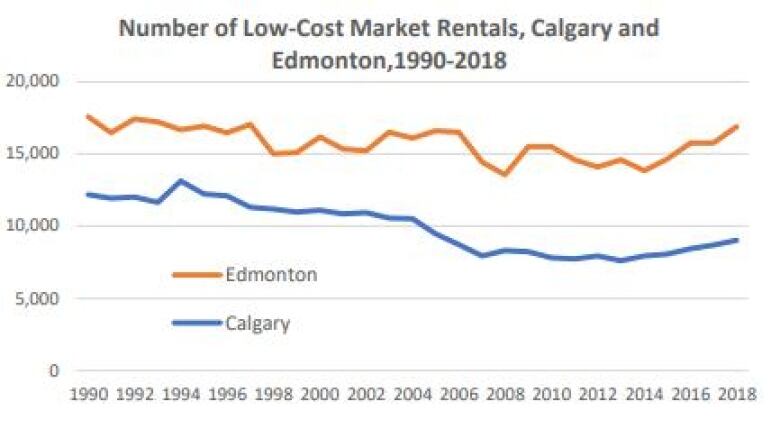Study asks why low-cost rentals in Calgary have dropped over the last three decades
New data shows that between 1990 and 2018, Calgary lost more than 3,000 low-cost units

When Susan James learned her apartment building in Calgary's Bankview neighbourhood was slated to be torn down, she needed to find a new home for herself and her nine-year-old daughter.
The only two-bedroom apartment the single mother could find within a stone's throw of her budget was a smoke-damaged unit in Southwood. When factoring in both rent and utilities, she said she'll be paying roughly $600 more permonth.
James, a health-care worker, plans to offset part of the cost by selling her plasma.
New data released Thursday by the University of Calgary's School of Public Policy says that the number of low-cost rental units in Calgary has decreased significantly over the last 30 years.
Economics professor Ron Kneebone, the report's author, said that since 1990, Calgary has lost over 3,000 low-cost rental units, adding that the city's population grew by more than half a million people during that time period.
"So when you look at it on a per capita basis, the number of low-cost rentals has fallen by nearly 60 per cent in Calgary," he said.
Tale of two cities
Kneebone's study looked at the number of the low-cost rental units in both Calgary and Edmonton between the years of 1990 and 2018, the lastyear for which figures were available.

But what explained the difference? Not rising incomes, Kneebone said, noting that inflation-adjusted median incomes for both cities rose by about 25 per cent.
The story was the same for construction costs. He said builders reported it costs roughly the same to construct a high-density apartment building in both cities.
Kneebone's report concluded that the difference between the two cities' low-cost rental unitscould be due to land use regulations at the municipal level, something researchers in both Canada and the U.S. are investigating as a possible avenue to explain the lack of affordable housing.
"So a possible explanation here is that the land use regulations in Calgary are driving up costs of low-end housing," he said.
"If that's true, then there's a solution here, and the solution lies at the feet of municipal governments in Calgary. They've got to look at what they're doing to impose costs on builders and how those costs can be reduced."
Land use regulations include things such as zoning laws, environmental impact review requirements, restrictions on the maximum height of buildings, and requirements to reach out to neighbourhood associations, among other things.
'You need it all'
From James' point of view, the lack of affordable housing for people of a modest income ripples through the city's social fabric, leading to more substance abuse issues, homelessness, and domestic violence.
"[Landlords] are increasing the rents because they can," she said. "That's it. Because the market will allow it."

Courtney Walcott, a Calgary city councillor who represents part of downtown, said rent caps, below-market housing and social housing are needed, along with changes to land use regulations.
"You need it all," he said."Any solution that doesn't have all of it, it's a failing solution."
In Walcott's view, the city has for years been responding to market pressures amid boom-and-bust cycles and never built a sustainable rental market.
Downtown is an example, he said. The city overbuilt for office industry and under-built residential, and now the city is working to rectify that.
To Kneebone, rent caps or controls are short-term solutions that create long-term problems. He advised against blaming the private sector before looking at how policies at the local level might prevent the construction of low-cost housing.
"People are coming to Calgary because it's an attractive place to live, but we have to make sure it's not just attractive to people with very high incomes," he said. "We also have to make sure the city can accommodate people with lower incomes."
According to Canada Mortgage and Housing Corporation, the average price of a two-bedroom rental apartment in Calgary grew six per cent last year, with an average monthly rent of $1,466.
With files from Karina Zapata, Paula Duhatschek












_(720p).jpg)


 OFFICIAL HD MUSIC VIDEO.jpg)
.jpg)



























































































